Here we define some key terms associated with Value Codes, including their structure and how they are put into action.
Value Code
A Value Code is a subjectively measurable representation of a thing that matters to an individual or group of people.
Value Codes codify any thing that matters in a way that lets you easily communicate what it is and ‘what good looks like’ to other stakeholders, have them evaluate it and account for its value.
Value Codes are designed to facilitate the evaluation of subjective value (value as experienced by the people best placed to know what matters, how and why it matters, and how it is performing) but can also be used to evaluate more objective capability or performance indicators (such as ‘number of units delivered on time’).
A Value Code is deliberately constrained to consist of a short Identifier, a more in-depth description, and five progressive Evaluation Level Labels and Evaluation Statements (ranging from ‘barely acceptable’ to ‘what good looks like’).
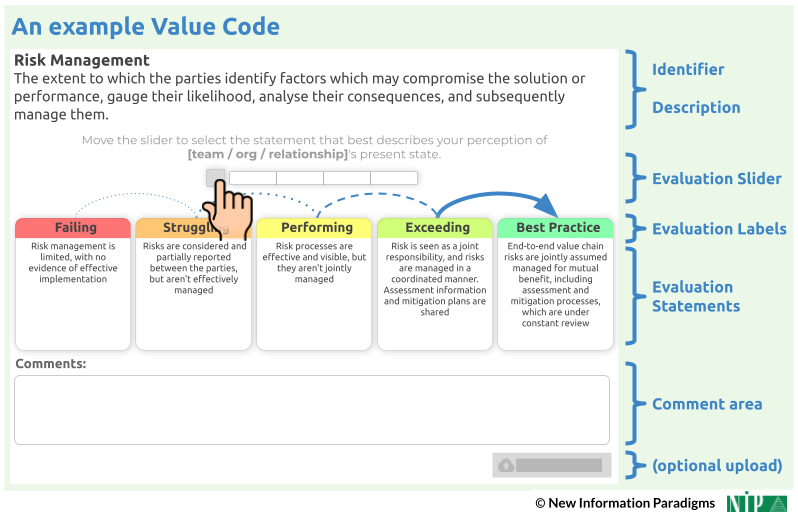
Image: An example Value Code
The five Value Code Evaluation Level Labels’ text may vary across Value Codes, but the colours are consistent (red, amber, yellow, lime and green). Consistent colours (rather than numbers) make it easy to gain meaningful ‘at a glance’ insights from individual Response Reports and reports generated from multiple responses.
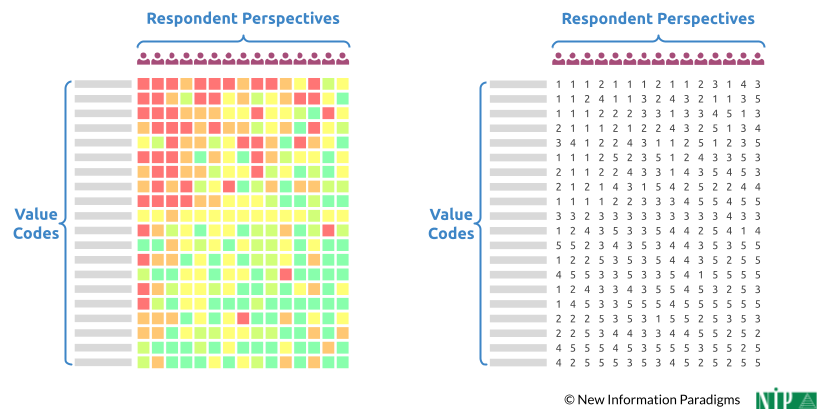
Image: Value Code colour heatmap compared to score table
Value Code Identifier
A Value Code Identifier is the short identifying label given to a Value Code.
Value Code Identifier should be as concise as possible and are ideally limited to no more than 2 or 3 words or 30 characters.
Concise Value Code Identifiers make it easier for people to recall and converse on a particular topic (helping to generate a shared language).
Concise Value Code Identifiers make it easier for people to gain high level insights from report charts (such as the Individual Response Report and multiple participant Heatmaps).
More in-depth detail about a Value Code is captured in the Value Code Description.
Value Code Identifiers are shown prominently at the point that they are evaluated by a respondent.
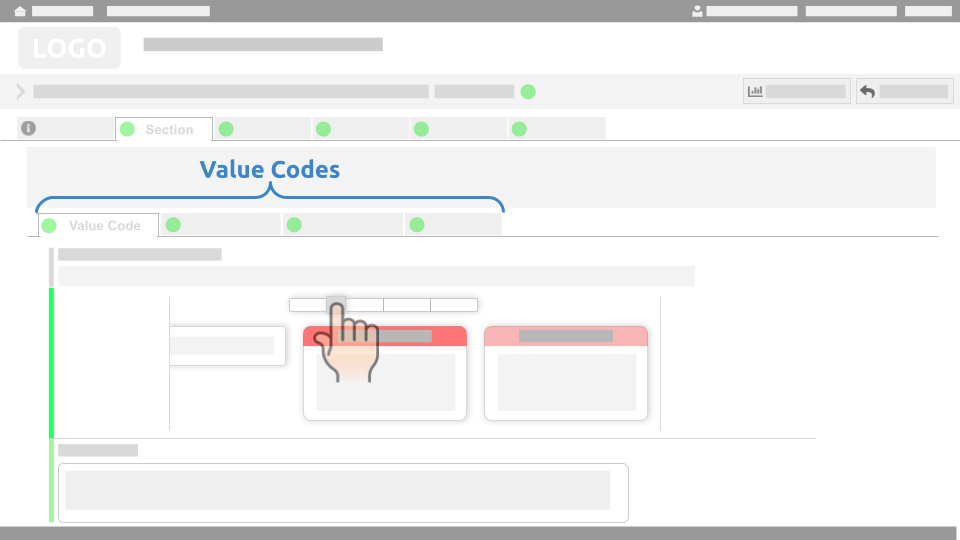
Image: Value Code Identifiers as shown to a respondent
Value Code Identifiers are shown in list form on an individual’s Response Report along with a colour indicating the Value Code Evaluation Level that was selected.

Image: Value Code Identifiers as shown on a response report
Value Code Identifiers are shown in graphical report charts to help people quickly identify score averages and distributions from larger numbers of participants.
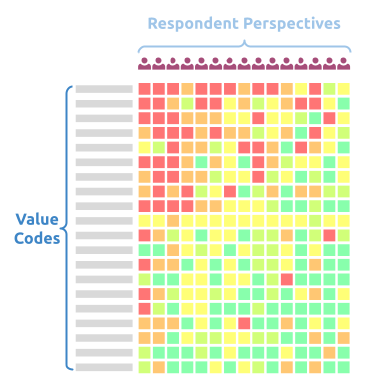
Image: Value Code Identifiers as shown on multi respondent reports
Each Value Code Identifier within a diagnostic has a unique name so that it isn’t confused with another Value Code. Short and unique Value Code Identifiers make report analysis and presentation quicker, easier and more meaningful.
Value Code Description
A Value Code Description captures more in-depth detail about the Value Code that is not able to fit into the Value Code Identifier.
The Value Code Description is ideally limited to no more than one or two sentences, or about 25 words, but may be longer.
A Value Code Description is often written in a form similar to:
“The extent to which [things that matter] are [implemented / evident / performing / etc]”.
Value Code Help Text
Value Code Help Text is text that is discretely visible to a Respondent as a clickable pop-up dialogue when evaluating a Value Code in an assessment system.
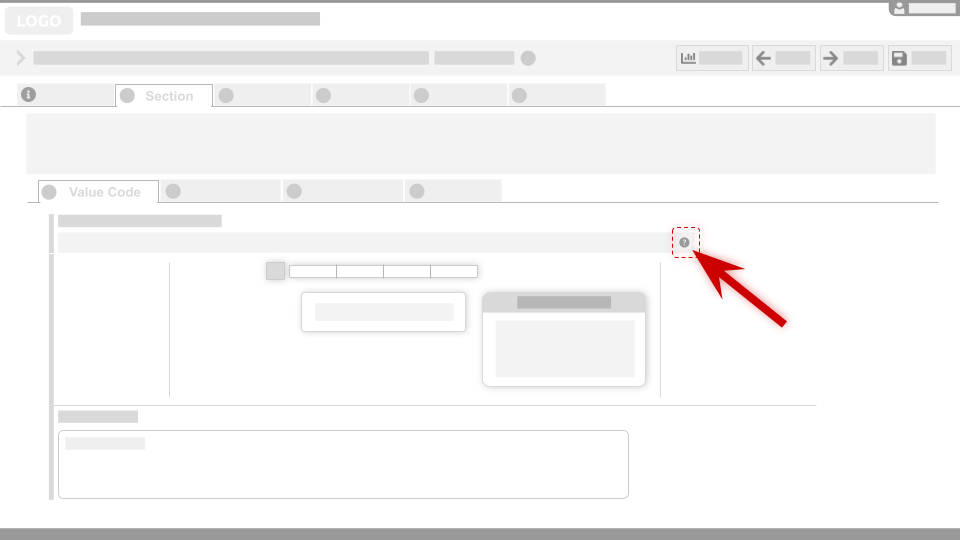
Image: Value Code Help Text as shown to a respondent
Value Code Help Text is optional (it may be left blank).
Value Code Help Text can be used to provide secondary information or context that some respondents might need in order to evaluate a Value Code (for instance, definitions of terms, links to related material, etc).
Value Code Evaluation Level Label
A Value Code Evaluation Level Label is a short (ideally only one or two words) top level description for each of the five Evaluation Statements.
Evaluation Level Labels are presented by default in the format ‘[Number] – [Evaluation Level Label]’ (e.g. ‘1 – Failing’)
Value Code Evaluation Level Labels are optional – they can be left blank and default to the numbers ‘1’ to ‘5’.
Value Code Evaluation Level numbers (‘1’ to ‘5’) are optional, but it is recommended to have either a label or a number or both.
Value Code Evaluation Level Labels should be consistent across all Value Codes within a specific diagnostic to facilitate summary reporting and comparison (for example: to allow you to report that “On average, across [a specific set of Value Codes], we evaluate our current state to be “5 – Strong”.”).
Value Code Evaluation Level Labels should correspond well to the associated Value Code Evaluation Statement (the Evaluation Level Label and Evaluation Statement should not contradict one another).
Value Code Evaluation Statement
A Value Code Evaluation Statement is a brief description of a perceivable state of things in relation to the Value Code itself.
Value Codes have five Evaluation Statements typically ranging from ‘what is barely acceptable’ to ‘what good looks like’.
Value Code Evaluation Statements enable a respondent to evaluate things that matter by reading each statement and simply selecting the one that best matches their subjective perspective.
Value Code Evaluation Statements provide greater clarity during evaluation than basic ‘likert scales’ (which typically only allow respondents to specify the extent to which they agree or disagree with one statement). This benefits the respondent by making it easier for them to perform the evaluation and makes the analysis of responses more meaningful as there are specific statements to go with each recorded score.
Unlike survey questions which are typically used to collect information into a central point, Value Code Evaluation Statements enable the communication of what matters and ‘what good looks like’ out to respondents. During the evaluation process, even if a respondent has to select a lower score to indicate the current state, their exposure to the higher evaluation statements will often inspire them to think about and put into action ideas on how to get to that more desired state in future (especially where Value Codes genuinely reflect the things that matter and there is an intention to continuously improve through repeated measurement).
Value Code Evaluation Statements are intended to morph over time as ‘what good looks like’ shifts due to ever changing current events, revised expectations about what good looks like or the general need for continuous improvement.
Each Value Code Evaluation Statement is ideally limited to no more than one or two sentences, or about 25 words, but may be longer.
Consistent sentence structure enables the Value Code Evaluation Statement to be used and reused in multiple ways, for example: checklists, evaluations, report summaries, action plans, etc.
Value Code Library
A Value Code Library is a collection of many different Value Codes and time/situation specific variations of Value Codes that can be drawn from to create focused and periodic Diagnostic evaluations / assessments.
Diagnostic
A Diagnostic is a focused collection of Value Codes that may be drawn from a Value Code Library or created as new (or a combination of both). A diagnostic is used to engage with multiple participants about things that matter.
A diagnostic evaluation process can be used in conjunction with Value Accelerators, but is usually set within the general contexts of acting to gain a better understanding of the current state or improving towards a desired future state.
